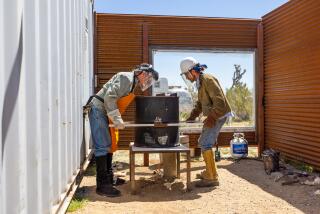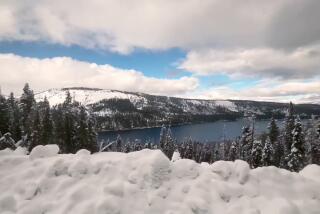A hawk’s-eye view while riding the desert wind
- Share via
Anza, Calif. — IN the middle of some work “crisis,” I sometimes look out the window of my office in downtown Los Angeles and watch the red-tail hawks drift in lazy circles as they ride the heat rising off the streets. One day in March, my wife, Rupa Goswami, and I played hooky from work to do what the hawks do: catch a thermal off the Earth.
The Warner Springs Airport, near Anza, has the largest glider or sail-plane operation in Southern California. The company based there, Sky Sailing, each year takes thousands of passengers soaring over the desert, where thermals are most common.
If you have ever flown to the Southwest in summer, you know what a thermal feels like: It’s that bump and pitch as the pilot brings the plane down to land. A thermal is caused by warm air rising off unevenly heated ground.
By the time we got to Warner Springs at 11 a.m., our pilot, Polly, had already taken up two groups of passengers and hadn’t had any luck finding thermals. There wasn’t much thermal activity because of recent rain and snow at higher elevations.
She explained how the glider worked, showed us the instruments and the tow-release lever and then tucked us into two snug seats behind her. Because gliders have no engine, the higher you are towed, the longer you stay up, and prices vary accordingly. Rupa and I paid $210 to be pulled up a mile -- 5,280 feet -- and ride for about 45 minutes. It is cheaper for a single passenger or for a shorter flight.
We bobbed and wobbled in the air behind the single-engine plane that towed us up in the sky. We felt like two kids being pulled along in a wagon. After a few minutes, the altimeter was over 5,000 feet. Polly signaled to the pilot and released the half-inch-thick cord between us.
Suddenly it was quiet. I wasn’t ready for that. With no engine sound, no seat vibration, this was the primeval dream of silent flight. It felt effortless, as though those long, slender wings outside the windows could hold us up forever. We felt no thermal, but Polly edged us over to a ridgeline east of Mt. Palomar and put us in an updraft to slow our descent.
We had a good, clear day. Sailing by the Santa Rosa Mountains, we could see Anza in a valley dusted lightly in snow. On the eastern horizon lay the gray Salton Sea. Lake Henshaw was crystal clear and the hills around it a springtime green. In the desert and lowland areas, wild poppies had broken out.
As we descended, Polly said that on a cold day even the vapors off the hot springs could create a thermal. We went over the springs, where I could see people bathing, but the altimeter steadily fell. We dipped into a mountain wash that was brown and bright.
Then, the glider lurched. I looked at the altimeter -- 1,100 feet, then 1,200. We were rising. Polly laughed and raised a thumb. “They’re down lower today,” she said. She dipped a wing just right to find the sweet spot. For five minutes and more, the warm air held us up in slow, lazy circles. Just like the hawks.
*
Sky Sailing at Warner Springs Airport, 31930 Highway 79, Warner Springs; (760) 782-0404, www.skysailing.com. Glider rides $110-$160 solo, $140-$220 for two.
More to Read
Sign up for The Wild
We’ll help you find the best places to hike, bike and run, as well as the perfect silent spots for meditation and yoga.
You may occasionally receive promotional content from the Los Angeles Times.






